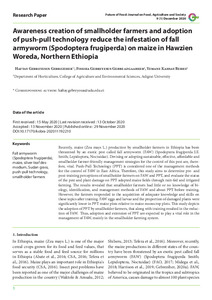| dc.date.accessioned | 2021-03-05T11:21:05Z | |
| dc.date.available | 2021-03-05T11:21:05Z | |
| dc.date.issued | 2020-11-28 | |
| dc.identifier | doi:10.17170/kobra-202011192210 | |
| dc.identifier.uri | http://hdl.handle.net/123456789/12585 | |
| dc.language.iso | eng | eng |
| dc.rights | Namensnennung 4.0 International | |
| dc.rights.uri | http://creativecommons.org/licenses/by/4.0/ | |
| dc.subject | fall armyworm (Spodoptera frugiperda) | eng |
| dc.subject | maize | eng |
| dc.subject | silver-leaf desmodium | eng |
| dc.subject | Sudan grass | eng |
| dc.subject | push-pull technology | eng |
| dc.subject | smallholder farmers | eng |
| dc.subject.ddc | 580 | |
| dc.subject.ddc | 630 | |
| dc.title | Awareness creation of smallholder farmers on and adoption of push-pull technology reduces fall armyworm (Spodoptera frugiperda) infestation on maize in Hawzien Woreda, Northern Ethiopia | eng |
| dc.type | Aufsatz | |
| dcterms.abstract | Recently, maize (Zea mays L.) production by smallholder farmers in Ethiopia has been threatened by an exotic pest called fall armyworm (FAW) (Spodoptera frugiperda J.E. Smith; Lepidoptera, Noctuidae). Devising or adopting sustainable, effective, affordable and smallholder farmers-friendly management strategies for the control of this pest are, therefore, vital. Push-Pull Technology (PPT) is considered one of the management methods for the control of FAW in East Africa. Therefore, the aim of this study is to determine pre- and post-training perceptions of smallholder farmers on FAW and PPT, and evaluate the status of the pest and plant damage on PPT adopted maize fields through rain-fed and irrigated farming. We found that the smallholder farmers had little or no knowledge of biology, identification, and management methods of FAW and about PPT before training. However, the farmers responded to the acquisition of adequate knowledge and skills on these topics after training. The FAW eggs and larvae and the proportion of plant damages were significantly lower in PPT treated maize plots relative to maize monocrop plots. This study depicts the adoption of PPT by smallholder farmers along with training resulted in the reduction of FAW. Thus, adoption and extension of PPT are expected to play a vital role in the management of FAW mainly in the smallholder farming system. | eng |
| dcterms.accessRights | open access | |
| dcterms.creator | Gebreziher, Haftay Gebreyesus | |
| dcterms.creator | Gebreazgaabher, Fissiha Gebreyesus | |
| dcterms.creator | Berhe, Yemane Kahsay | |
| dc.subject.swd | Spodoptera frugiperda | ger |
| dc.subject.swd | Mais | ger |
| dc.subject.swd | Sudangras | ger |
| dc.subject.swd | Biologische Schädlingsbekämpfung | ger |
| dc.subject.swd | Kleinbauer | ger |
| dc.type.version | publishedVersion | |
| dcterms.source.identifier | EISSN 2197-411X | |
| dcterms.source.issue | No. 1 | |
| dcterms.source.journal | Future of Food: Journal on Food, Agriculture & Society | eng |
| dcterms.source.volume | Vol. 9 | |
| kup.iskup | false | |
| dcterms.source.articlenumber | 329 | |


